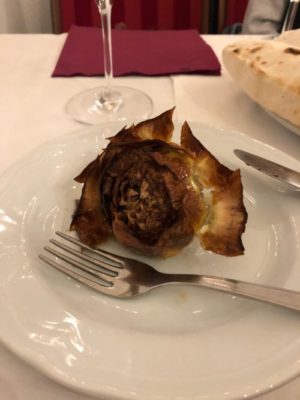Don’t be Artichoked by Gross Vegetables: Eat the Roman Fried Artichoke!

While studying abroad in Italy, Caroline Carr was able to try a Jewish-style artichoke. Courtesy of Caroline Carr

By Caroline Carr
The Artichoke originating in the Mediterranean
This dish referred to as Jewish-style because the artichokes are fried in a very specific way. Most fried food is cooked using pork fat, however, due to the rules of kosher, which stipulate that the Jewish people should not eat pork, olive oil is used rather than pork fat. Many people who follow the Jewish religion do not eat pork because the Bible states that animals that do not “chew the cud” are “unclean,”
Many “Jewish-style” foods have influenced Roman food culture. The Jewish people living in Rome were confined to the Jewish Ghetto or, as the people of Rome say, “Il Ghetto.” Pope Paul IV confined the Jews to this part of Rome across from Trastevere, on the opposite side of the Tiber river. He also controlled what kind of professions the Jews could engage in forcing them to participate in occupations associated with food preparation. Due to the fact that making food was one of the only occupations permitted to the Jewish people, they created
“Jews from various phases of the diaspora, from as far back as the 2nd century BC and from places as diverse as the Levant, northern Europe, Spain, and north Africa, adapted their distinctive ingredients and traditions (including dietary restrictions) to their new homes, influencing Italy’s diverse regional cuisines in the process,”said Joshua Samuels, an anthropology professor at Catholic University. “In my experience, [this dish is] definitely associated with Jewish Roman cuisines, fried dishes like suppli are more universally Roman.”
The taste of the
“I think they are the most amazing food to have been created they are both salty and crunchy but also bitter and soft in the heart of the artichoke. I like that they aren’t breaded when they are fried and I think they are better when they are soaked in lemon juice prior to them being fried,” said Meghan Crawford a junior, psychology major student at the Catholic University of America. “If you are to get a fried artichoke in the United States you have to go to
Not everyone enjoys the taste of the fried artichoke, however, for a tourist visiting Rome or, more specifically, the Jewish Ghetto, this dish is a cultural experience that every person should engage in. There is an expansive history in this specific area and with this particular dish. Eating this dish allows you to participate in a piece of Roman history and food culture. Tourists eating this dish in the Jewish Ghetto, should try the very popular restaurant Nonna Betta or outside the Ghetto in Trastevere at Da Gildo. Either way, eating this dish is an unforgettable experience.







